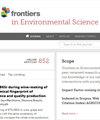双赢还是权衡?地点和战略决定了保护、恢复和农林业的碳效益和当地生态系统服务效益
IF 3.3
3区 环境科学与生态学
Q2 ENVIRONMENTAL SCIENCES
引用次数: 0
摘要
基于自然的解决方案(NBS)可为人类福祉带来诸多益处,包括一些对气候适应至关重要的益处。我们通过模拟全球气候变化减缓和当地生态系统服务(水供应、沉积物保留、径流、授粉、氮保留、绿水存储和海岸保护),定量评估了保护、恢复和农林业等 NBS 战略的全球潜力。最有可能帮助人类的策略并不一定能带来最大的气候变化减缓效果:就每一保护行动区域而言,农林业为平均三倍于植树造林的人口提供了大量益处(至少一种当地生态系统服务增加 20% 以上),而每单位区域的固碳量却不到植树造林的十分之一。每种策略都能带来不同的生态系统服务效益;例如,避免森林转换可大幅增加氮的保留量(如果在全球全面实施,可使 7200 万人的氮保留量增加 100%),而农林业可增加授粉服务(如果在全球全面实施,可使 30 亿人的授粉服务增加 100%)。这里模拟的所有国家生物多样性战略都有一个共同的缺点,即木质生物量的增加会增加蒸腾作用,从而减少年径流量,并在某些流域对当地的水供应产生负面影响。此外,减缓气候变化潜力最大的地方并不一定是人口最多的地方。例如,拉丁美洲的重新造林具有最大的气候变化减缓潜力,但最大的生态系统服务效益却在非洲。将重点放在气候变化减缓潜力大且当地生态系统服务潜力大的国家,如重新造林的尼日利亚、农林业的印度以及避免森林转换的刚果共和国,有助于确定双赢的实施地点。我们发现,在面积达 580 万平方公里的关键地点集中实施这三种保护战略,可增加当地生态系统服务的提供,使 20 亿人受益。这些关键地点仅占可能实施区域的 35%,但却能为此处研究的国家生物多样性战略方案下的选定生态系统服务提供 80% 的全球效益。我们的结论是,针对这些关键地点进行保护、恢复和农林业干预将是实现适应和人类福祉目标的关键,同时还能增加基于自然的碳减排。本文章由计算机程序翻译,如有差异,请以英文原文为准。
Win-wins or trade-offs? Site and strategy determine carbon and local ecosystem service benefits for protection, restoration, and agroforestry
Nature-based solutions (NBS) can deliver many benefits to human wellbeing, including some crucial to climate adaptation. We quantitatively assess the global potential of NBS strategies of protection, restoration, and agroforestry by modeling global climate change mitigation and local ecosystem services (water availability, sediment retention, runoff, pollination, nitrogen retention, green water storage, and coastal protection). The strategies with the most potential to help people do not necessarily deliver the most climate change mitigation: per area of conservation action, agroforestry provides substantial benefits (>20% increase in at least one local ecosystem service) to three times more people on average than reforestation while providing less than one tenth the carbon sequestration per unit area. Each strategy delivers a different suite of ecosystem service benefits; for instance, avoided forest conversion provides a strong increase in nitrogen retention (100% increase to 72 million people if fully implemented globally) while agroforestry increases pollination services (100% increase to 3.0 billion people if fully implemented globally). One common disservice shared by all the NBS strategies modeled here is that increased woody biomass increases transpiration, reducing annual runoff and in some watersheds negatively impacting local water availability. In addition, the places with the greatest potential for climate change mitigation are not necessarily the ones with the most people. For instance, reforestation in Latin America has the greatest climate change mitigation potential, but the greatest ecosystem service benefits are in Africa. Focusing on nations with high climate mitigation potential as well as high local ecosystem service potential, such as Nigeria in the case of reforestation, India for agroforestry, and the Republic of Congo for avoided forest conversion, can help identify win-win sites for implementation. We find that concentrating implementation of these three conservation strategies in critical places, covering 5.8 million km2, could benefit 2.0 billion people with increased local ecosystem services provision. These critical places cover only 35% of the possible area of implementation but would provide 80% of the benefits that are possible globally for the selected set of ecosystem services under the NBS scenarios examined here. We conclude that targeting these critical places for protection, restoration, and agroforestry interventions will be key to achieving adaptation and human wellbeing goals while also increasing nature-based carbon mitigation.
求助全文
通过发布文献求助,成功后即可免费获取论文全文。
去求助
来源期刊

Frontiers in Environmental Science
Environmental Science-General Environmental Science
CiteScore
4.50
自引率
8.70%
发文量
2276
审稿时长
12 weeks
期刊介绍:
Our natural world is experiencing a state of rapid change unprecedented in the presence of humans. The changes affect virtually all physical, chemical and biological systems on Earth. The interaction of these systems leads to tipping points, feedbacks and amplification of effects. In virtually all cases, the causes of environmental change can be traced to human activity through either direct interventions as a consequence of pollution, or through global warming from greenhouse case emissions. Well-formulated and internationally-relevant policies to mitigate the change, or adapt to the consequences, that will ensure our ability to thrive in the coming decades are badly needed. Without proper understanding of the processes involved, and deep understanding of the likely impacts of bad decisions or inaction, the security of food, water and energy is a risk. Left unchecked shortages of these basic commodities will lead to migration, global geopolitical tension and conflict. This represents the major challenge of our time. We are the first generation to appreciate the problem and we will be judged in future by our ability to determine and take the action necessary. Appropriate knowledge of the condition of our natural world, appreciation of the changes occurring, and predictions of how the future will develop are requisite to the definition and implementation of solutions.
Frontiers in Environmental Science publishes research at the cutting edge of knowledge of our natural world and its various intersections with society. It bridges between the identification and measurement of change, comprehension of the processes responsible, and the measures needed to reduce their impact. Its aim is to assist the formulation of policies, by offering sound scientific evidence on environmental science, that will lead to a more inhabitable and sustainable world for the generations to come.
 求助内容:
求助内容: 应助结果提醒方式:
应助结果提醒方式:


